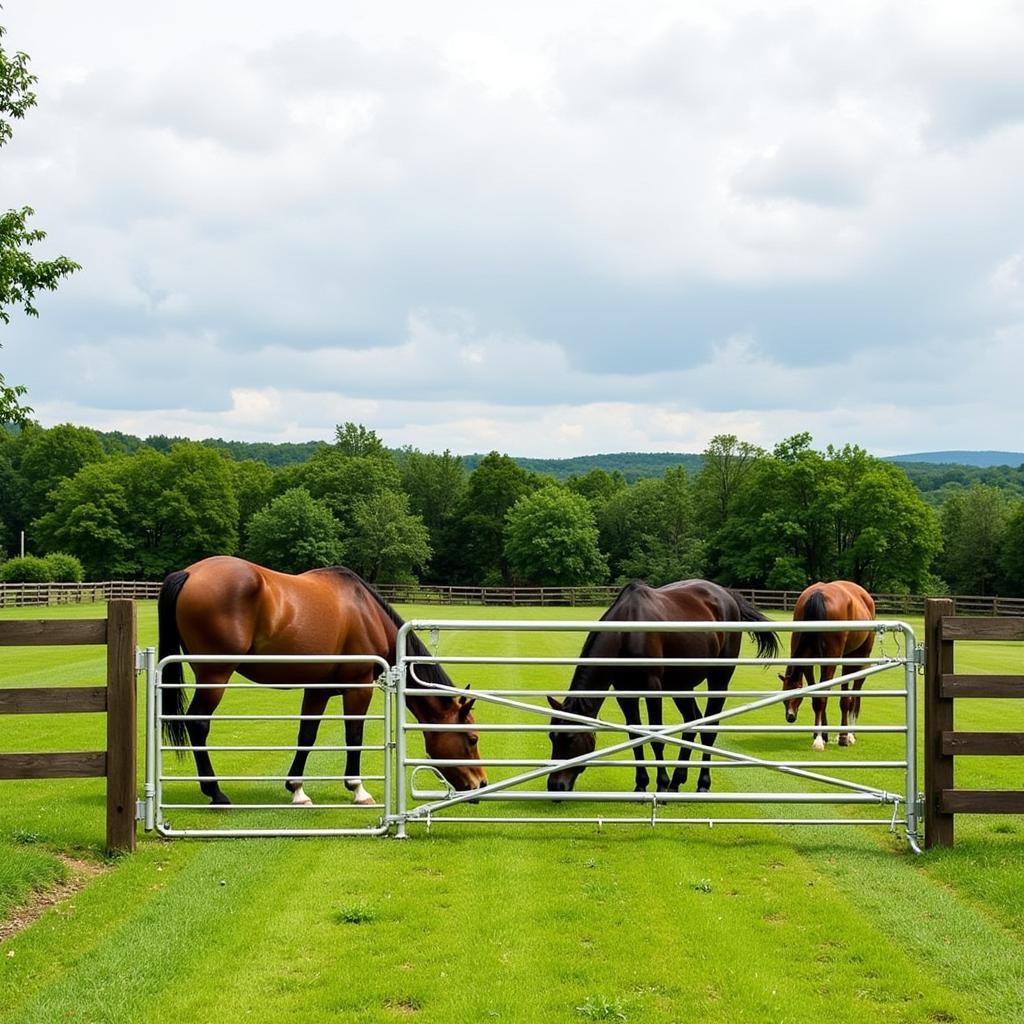The Barton horse gate, a seemingly simple farm fixture, holds a fascinating history deeply rooted in equestrian tradition and practicality. More than just a gate, its clever design speaks volumes about the close relationship between humans and horses, showcasing a blend of ingenuity and functionality that has stood the test of time.
Originating from Practical Needs
The Barton horse gate emerged in the rural landscapes of England, likely evolving over generations of farmers seeking efficient ways to manage their livestock and land. The name itself hints at its origins, “barton” being an old English term for a farmyard or agricultural enclosure. This type of gate, with its distinctive angled bars, was specifically developed to contain horses while allowing other animals, like sheep or smaller livestock, to pass through freely.
 Horses Grazing near Barton Horse Gate
Horses Grazing near Barton Horse Gate
The Genius of the Slant
The key to the Barton horse gate’s success lies in its ingenious slanted design. The top rail of the gate slopes downwards, creating a barrier that horses, with their keen sense of depth perception, are naturally hesitant to jump over. This sloping top rail effectively discourages horses from attempting to escape while simultaneously allowing smaller animals to squeeze through the wider gaps at the bottom. This ingenious solution eliminated the need for separate gates or complex fencing systems, simplifying farm management and minimizing the risk of horses getting loose.
More Than Just a Barrier: Symbolism and Craftsmanship
Beyond its practical applications, the Barton horse gate has become a cherished symbol of rural heritage and traditional craftsmanship. The gates are often constructed using locally sourced wood, and their sturdy build speaks to the skilled carpentry often passed down through generations. Each gate tells a story, bearing witness to the passage of time and the enduring bond between humans and their equine companions.
The Barton Horse Gate Today: A Timeless Design
In today’s world, while modern fencing solutions are readily available, the Barton horse gate hasn’t lost its appeal. It continues to be a popular choice for horse owners and enthusiasts who appreciate its timeless elegance, practical functionality, and historical significance. These gates are not only functional barriers but also beautiful additions to farms, ranches, and rural properties, adding a touch of rustic charm and echoing a bygone era of equestrian tradition.
FAQs about Barton Horse Gates
1. Are Barton horse gates safe for horses?
Yes, the design of the Barton horse gate is inherently safe for horses. The sloping top rail and wide bottom spacing deter jumping and prevent legs from getting caught.
2. Can I build my own Barton horse gate?
Absolutely! With some basic carpentry skills and the right plans, you can build your own Barton horse gate.
3. What type of wood is best for a Barton horse gate?
Hardwoods like oak or cedar are ideal for their durability and weather resistance.
4. How wide should a Barton horse gate be?
The width can vary depending on your needs, but a standard size is around 4 feet.
5. Where can I buy a Barton horse gate?
You can find Barton horse gates at farm supply stores, online retailers, or through specialized builders.
Need help with your horses?
Contact Justus Horses USA! We are dedicated to providing you with the best information and resources for all your equine needs. Call us at 0772127271, email us at [email protected], or visit us at QGM2+WX2, Vị Trung, Vị Thuỷ, Hậu Giang, Việt Nam. Our team is available 24/7 to assist you.